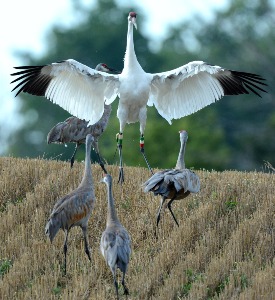
After 25 years, Operation Migration has come to an end. The nonprofit organization Operation Migration’s purpose was to restore the number of whooping cranes migrating to the southern United States from the eastern United States. Started in 2001, the organization receives whooping crane chicks hatched at captive breeding sites throughout North America. Today, more than 100 of these cranes migrate between Wisconsin and southeastern states.
“We raised the birds by hand. We wore costumes and didn’t talk in their presence. And they remained wild. But it was us they were looking to for guidance, and that’s what allowed us to lead them South,” stated Operation Migration co-founder and CEO Joe Duff.
Operation Migration initially cared for eight baby chicks in 2001; but in recent years, they received up to 20 annually. This is because of the national attention that was brought to the organization. The organization rose to fame for teaching chicks how to migrate from Wisconsin to Florida, guided by human pilots.
In 2015, the Recovery Team, a partnership between the U.S. Fish and Wildlife Service and Canadian Wildlife Service, made a joint decision to end the ultralight-led migration. Later that year, Operation Migration declared that they no longer believe that they can maintain a sustainable population of eastern migratory whooping cranes. Duff stressed how it is wrong for a nonprofit organization to receive money for something with no faith.
With whooping crane populations on the rise, the U.S. Fish and Wildlife Service has decided to shift towards a more natural reintroduction model. This means ending the use of plane-led migration and human caregivers to raise chicks. There is hope that this change will allow cranes to learn more natural rearing skills and reduce chick mortality rates, as adult birds are struggling to care for the younger chicks. However, this approach is limiting, because there are only so many chicks to be raised using parent-rearing.
“We’re getting very few birds, in fact, this year we’re only getting four altogether,” Duff stated, “the population is just going to dwindle and dwindle and pretty soon it’ll be gone.”
Opponents such as Margaret Howden are upset about Operation Migration coming to an end. “I’m furious at Fish and Wildlife….They’re basically going to ruin […] years of work….There is no way that that population will be able to maintain. All of this work – blood, sweat, tears, donations,” Howden stated.
In the early 1940s, whooping cranes became extinct in the eastern United States due to hunting and habitat loss. With the help of many organizations and agencies, these birds have made a recovery from extinction. Losing a huge advocate like Operation Migration can be devastating. But retired Madison environmental scientist Mary O’Brien is fighting to fill the hole that the organization left behind. She is eager to work with the International Crane Foundation in Baraboo, a group that is known to cater programs for young people.
“The International Crane Foundation […] already do[es] a lot of outreach and programs for young people. We need to continue to get kids involved in this because they’re the next conservationists,” says O’Brien.
Finding a new approach in hopes of fixing the whooping crane population is critical, according to International Crane Foundation chief operating officer Kim Smith. But there will be challenges without Operation Migration, and O’Brien knows that their contributions cannot be overlooked. “We just keep working at it until something works. We’re always trying new things. It’s a loss with Operation Migration, but changes happen,” Smith stated.
Once found all across North America, whooping birds are now among the rarest birds on the continent. These majestic birds are not just a pretty sight to see in the early morning, but they are important to the environment and ecosystem. People such as Mary O’Brien and Kim Smith are playing a crucial role for the birds. Without them, whooping cranes would go extinct once again.
[Sources:
Isthmus
;
Wisconsin State Journal; Madison.com; International Crane Foundation; WI DNR
]

